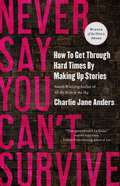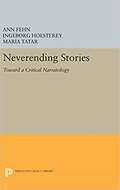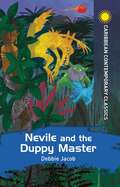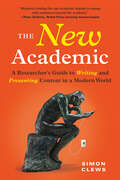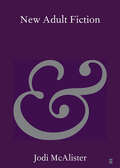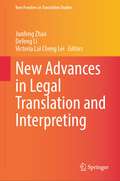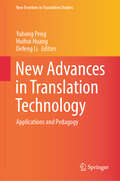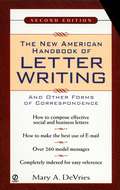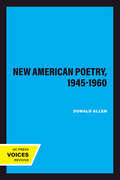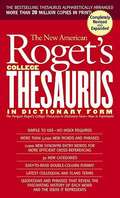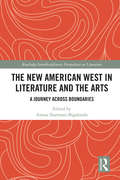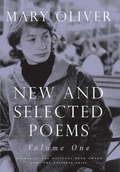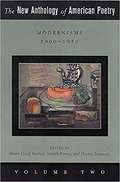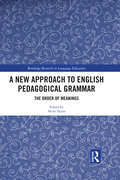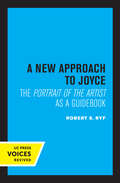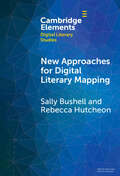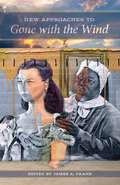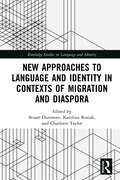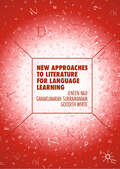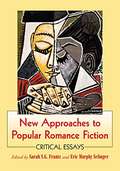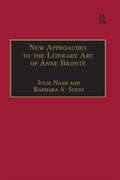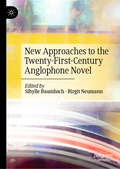- Table View
- List View
Never Say You Can't Survive
by Charlie Jane AndersWINNER OF THE 2022 HUGO AWARD FOR BEST RELATED WORKFrom Charlie Jane Anders, the award-winning author of novels such as All the Birds in the Sky and The City in the Middle of the Night, this is one of the most practical guides to storytelling that you will ever read.The world is on fire.So tell your story.Things are scary right now. We’re all being swept along by a tidal wave of history, and it’s easy to feel helpless. But we’re not helpless: we have minds, and imaginations, and the ability to visualize other worlds and valiant struggles. And writing can be an act of resistance that reminds us that other futures and other ways of living are possible.Full of memoir, personal anecdote, and insight about how to flourish during the present emergency, Never Say You Can’t Survive is the perfect manual for creativity in unprecedented times.At the Publisher's request, this title is being sold without Digital Rights Management Software (DRM) applied.
Neverending Stories: Toward A Critical Narratology (Princeton Legacy Library #1209)
by Ann Fehn Ingeborg Hoesterey Maria TatarIn these compelling new essays, leading critics sharpen our understanding of the narrative structures that convey meaning in fiction, taking as their point of departure the narratological positions of Dorrit Cohn, Grard Genette, and Franz Stanzel. This collection demonstrates how narratology, with its attention to the modalities of presenting consciousness, offers a point of entry for scholars investigating the socio-cultural dimensions of literary representations. Drawing from a wide range of literary texts, the essays explore the borderline between fiction and history; explain how characters are constructed by both author and reader through the narration of consciousness; show how gender shapes narrative strategies ranging from the depiction of consciousness through intertextuality to the representation of the body; address issues of contingency in narrative; and present a debate on the crucial function of person in the literary text. The contributors are Stanley Corngold, Gail Finney, Kte Hamburger, Paul Michael Ltzeler, David Mickelsen, John Neubauer, Thomas Pavel, Jens Rieckmann, Shlomith Rimmon-Kenan, Judith Ryan, Franz Stanzel, Susan Suleiman, Maria Tatar, David Wellbery, and Larry Wolff.
Nevile and the Duppy Master
by Debbie JacobThis second book in the Nevile series takes the band of companions deeper into the mystery of the evil king's rise to power. Can he be brought to justice?Suspicion looms large and deception rules the day as Nevile plots to depose the evil king of Aribbea in the year 2222. To succeed, the famous bridge builder must convince Nina, A.T. and Hunn Dread to support his mission, but everyone feels torn in different directions. Nina's bond with Hanuman the monkey leads her on a new path in life; A.T. is content with power over his own canton and Hunn Dread emerges as Nevile's rival for Nina's affection. As usual, Pierre the bacoo is sneaking off to stir up trouble with his lies. Success now depends on Nevile questioning the Royal Record Keeper to unlock the mystery of the keys in the treasure chest Nina discovered when she first found land and changed the course of the three bridgers' lives. Nevile's first test comes in Xaymaca's elfin forest where duppies confront Nevile's party. Will Nevile unite his friends, Papa Bois' folk, the bridgers and the salt miners to overthrow the king? Will he feel forced to choose between Nina and Seamstress Number 2, who once saved his life? Will he discover SN2's secret? Excitement mounts and tempers flare as Nevile builds his fighting force joined by a second Guyanese genie, a duppy and a forest creature. Will Nevile win freedom for Aribbea from the king?
Nevile and the Duppy Master (Caribbean Modern Classics)
by Debbie JacobThis second book in the Nevile series takes the band of companions deeper into the mystery of the evil king's rise to power. Can he be brought to justice?Suspicion looms large and deception rules the day as Nevile plots to depose the evil king of Aribbea in the year 2222. To succeed, the famous bridge builder must convince Nina, A.T. and Hunn Dread to support his mission, but everyone feels torn in different directions. Nina's bond with Hanuman the monkey leads her on a new path in life; A.T. is content with power over his own canton and Hunn Dread emerges as Nevile's rival for Nina's affection. As usual, Pierre the bacoo is sneaking off to stir up trouble with his lies. Success now depends on Nevile questioning the Royal Record Keeper to unlock the mystery of the keys in the treasure chest Nina discovered when she first found land and changed the course of the three bridgers' lives. Nevile's first test comes in Xaymaca's elfin forest where duppies confront Nevile's party. Will Nevile unite his friends, Papa Bois' folk, the bridgers and the salt miners to overthrow the king? Will he feel forced to choose between Nina and Seamstress Number 2, who once saved his life? Will he discover SN2's secret? Excitement mounts and tempers flare as Nevile builds his fighting force joined by a second Guyanese genie, a duppy and a forest creature. Will Nevile win freedom for Aribbea from the king?
The New Academic: A Researcher's Guide to Writing and Presenting Content in a Modern World
by Simon ClewsWhat does it mean to be an academic in today's rapidly changing world?As a modern academic, you're expected to wear many hats. It's not enough to be outstanding in your chosen field. You also need to be able to connect with audiences, speak with wit and flair, write knock-out articles, attract media attention, and share it all with your huge social media following. But how do you do all of that?In The New Academic, Simon Clews offers a wealth of practical advice on how to write and speak in an entertaining, informative, and—above all else—accessible way. Aimed at researchers at all levels of experience, this book will set you up with the basics of writing and speaking for wide audiences, then teach you how to develop a public profile and gain traction online. In a rapidly changing world, The New Academic shows scholars how to be front and center in the public conversation, allowing more people to benefit from their knowledge and research.Funny, lively, and insightful, this is your hands-on guide for sharing your research with the world.
New Adult Fiction (Elements in Publishing and Book Culture)
by Jodi McAlisterThe term 'new adult' was coined in 2009 by St Martin's Press, when they sought submissions for a contest for 'fiction similar to YA that can be published and marketed as adult – a sort of 'older YA' or 'new adult'.' However, the literary category that later emerged bore less resemblance to young adult fiction and instead became a sub-genre of another major popular genre: romance. This Element uses new adult fiction as a case study to explore how genres develop in the twenty-first-century literary marketplace. It traces new adult's evolution through three key stages in order to demonstrate the fluidity that characterises contemporary genres. It argues for greater consideration of paratextual factors in studies of genre. Using a genre worlds approach, it contends that in order to productively examine genre, we must consider industrial and social factors as well as texts.
New Advances in Legal Translation and Interpreting (New Frontiers in Translation Studies)
by Junfeng Zhao Defeng Li Victoria Lai Cheng LeiThis book describes interdisciplinary exploration of matters related to the translation and interpreting of legal texts. Translation of legal texts has grown exponentially since the beginning of new millennium in response to the fast-increasing volume of international trade and business as well as all sorts of other transnational activities in a myriad of spheres. International trade demands translation of trade laws and business contracts, immigration leads to rise in court interpreting services, and countries may seek to enhance their international influence through translating and making known to the world their laws and/or other legal documents. These legal translation activities occurred mostly between languages officially used in international or regional organizations, such as the United Nations and the European Union, and between the languages of major countries who exert or seek influence on international economy and law. On the other hand, rapid advances in computer technology and artificial intelligence in recent years have also brought about changes in the practices of legal translation. With changes also come problems in both theory and practice that merit our immediate attention. This edited volume highlights the newest developments in the theory, practice, and training of legal translation, with contributions from international leading researchers in this area. It will be a standard reference for anyone who is to embark on research and practice of legal translation in the twenty-first century. It is also adaptable as teaching materials for translation and interpreting training.
New Advances in Translation Technology: Applications and Pedagogy (New Frontiers in Translation Studies)
by Defeng Li Yuhong Peng Huihui HuangFrom using machine learning to shave seconds off translations, to using natural language processing for accurate real-time translation services, this book covers all the aspects. The world of translation technology is ever-evolving, making the task of staying up to date with the most advanced methods a daunting yet rewarding undertaking. That is why we have edited this book—to provide readers with an up-to-date guide to the new advances in translation technology. In this book, readers can expect to find a comprehensive overview of all the latest developments in the field of translation technology. Not only that, the authors dive into the exciting possibilities of artificial intelligence in translation, exploring its potential to revolutionize the way languages are translated and understood. The authors also explore aspects of the teaching of translation technology. Teaching translation technology to students is essential in ensuring the future of this field. With advances in technology such as machine learning, natural language processing, and artificial intelligence, it is important to equip students with the skills to keep up with the latest developments in the field. This book is the definitive guide to translation technology and all of its associated potential. With chapters written by leading translation technology experts and thought leaders, this book is an essential point of reference for anyone looking to understand the breathtaking potential of translation technology.
New Adventures: A Harcourt Reading Program (Grade #3)
by HarcourtAn interactive set of short stories with exercises focusing on specific skills like, prefixes and suffixes, vocabulary, synonyms and antonyms etc.
The New American Handbook of Letter Writing
by De Vries Mary A.Completely revised and updated, this guide to all forms of correspondence includes more than 260 model messages to help readers master all forms of communication, whether a traditional letter or business e-mail. Appropriate tone, sentence length, and language are covered, as well as proper stationery, format, and the use of computers.
The New American Poetry, 1945-1960
by Donald AllenWith more than 100,000 copies sold, The New American Poetry has become one of the most influential anthologies published in the United States since World War II. As one of the first counter-cultural collections of American verse, this volume fits in Robert Lowell's famous definition of the raw in American poetry. Many of the contributors once derided in the mainstream press of the period are now part of the postmodern canon: Olson, Duncan, Creeley, Guest, Ashbery, Ginsberg, Kerouac, Levertov, O'Hara, Snyder, Schuyler, and others. Donald Allen's The New American Poetry delivered the first taste of these remarkable poets, and the book has since become an invaluable historical and cultural record, now available again for a new generation of readers.
The New American Poetry and Cold War Nationalism (Modern and Contemporary Poetry and Poetics)
by Stephan DelbosThis book examines Donald M. Allen’s crucially influential poetry anthology The New American Poetry, 1945–1960 from the perspectives of American Cold War nationalism and literary transnationalism, considering how the anthology expresses and challenges Cold War norms, claiming post-war Anglophone poetic innovation for the United States and reflecting the conservative American society of the 1950s. Examining the crossroads of politics, social life, and literature during the Cold War, this book puts Allen’s anthology into its historical context and reveals how the editor was influenced by the volatile climate of nationalism and politics that pervaded every aspect of American life during the Cold War. Reconsidering the dramatic influence that Allen’s anthology has had on the way we think about and anthologize American poetry, and recontextualizing The New American Poetry as a document of the Cold War, this study not only helps us come to a more accurate understanding of how the anthology came into being, but also encourages new ways of thinking about all of Anglophone poetry, from the twentieth century and today.
The New American Roget's College Thesaurus: In the Dictionary Form
by Philip D. MoreheadPublished in hardcover as The Penguin Roget's College Thesaurus in Dictionary Form, this new paperback edition of the 20-million-copy bestselling thesaurus has been fully revised, expanded, and updated for the modern home, school, or office. .
The New American West in Literature and the Arts: A Journey Across Boundaries (Routledge Interdisciplinary Perspectives on Literature)
by Amaia Ibarraran-BigalondoThe story of the American West is that of a journey. It is the story of a movement, of a geographical and human transition, of the delineation of a route that would soon become a rooted myth. The story of the American West has similarly journeyed across boundaries, in a two-way movement, sometimes feeding the idea of that myth, sometimes challenging it. This collection of essays relates to the notion of the traveling essence of the myth of the American West from different geographical and disciplinary standpoints. The volume originates in Europe, in Spain, where the myth traveled, was received, assimilated, and re-presented. It intends to travel back to the West, in a two-way cross-cultural journey, which will hopefully contribute to the delineation of the New—always self-renewing—American West. It includes the work of authors of both sides of the Atlantic ocean who propose a cross-cultural, transdisciplinary dialogue upon the idea, the geography and the representation of the American West.
New and Selected Poems, Volume One
by Mary OliverWhen New and Selected Poems, Volume One was originally published in 1992, Mary Oliver was awarded the National Book Award. In the fourteen years since its initial appearance it has become one of the best-selling volumes of poetry in the country. This collection features thirty poems published only in this volume as well as selections from the poet's first eight books.<P><P> Mary Oliver's perceptive, brilliantly crafted poems about the natural landscape and the fundamental questions of life and death have won high praise from critics and readers alike. "Do you love this world?" she interrupts a poem about peonies to ask the reader. "Do you cherish your humble and silky life?" She makes us see the extraordinary in our everyday lives, how something as common as light can be "an invitation/to happiness,/and that happiness,/when it's done right,/is a kind of holiness,/palpable and redemptive." She illuminates how a near miss with an alligator can be the catalyst for seeing the world "as if for the second time/the way it really is." Oliver's passionate demonstrations of delight are powerful reminders of the bond between every individual, all living things, and the natural world.<P> Winner of the National Book Award
The New Anthology of American Poetry, Volume Two: Modernisms: 1900-1950
by Steven Axelrod Camille Roman Thomas TravisanoBringing together fifty years of exciting modernisms, The New Anthology of American Poetry, Volume 2 includes over 600 poems by sixty-five American poets writing in the period between 1900 and 1950. The most recognized poets of the era, such as William Carlos Williams, Ezra Pound, Wallace Stevens, T. S. Eliot, H. D., Gertrude Stein, Robert Frost, Marianne Moore, Hart Crane, and Langston Hughes are represented, along with many other Harlem Renaissance poets, women poets, immigrant and working-class poets, imagists, and objectivists. It is also the first modernist anthology to include poems and songs from popular culture.
A New Approach to English Pedagogical Grammar: The Order of Meanings (Routledge Research in Language Education)
by Akira TajinoThis book proposes Meaning-order Approach to Pedagogical Grammar (MAP Grammar) as a practical pedagogical approach in ESL and EFL contexts. Teaching grammar through an easy-to-understand three-dimensional model, MAP Grammar establishes the clause as the fundamental unit of English and interprets meaning units in the sentence, thus allowing visualizable association between individual grammar items. By focusing on the order of meaning (rather than the order of words) in a sentence, MAP Grammar also distills current descriptive sentence structures (typically taught as five or seven patterns) into one meaning-based sentence structure for teaching and learning. MAP Grammar makes syllabus design and teaching easier in the following ways: Visualizing English grammar in a clear model, allowing association between individual grammar items. Instruction relies on meaning, not metalanguage, making MAP Grammar easy to grasp. The meaning-based sentence structure allows teachers to address global errors, and learners to produce comprehensible English.
A New Approach to Joyce: The Portrait of the Artist as a Guidebook
by Robert S. RyfThis title is part of UC Press's Voices Revived program, which commemorates University of California Press’s mission to seek out and cultivate the brightest minds and give them voice, reach, and impact. Drawing on a backlist dating to 1893, Voices Revived makes high-quality, peer-reviewed scholarship accessible once again using print-on-demand technology. This title was originally published in 1962.
New Approaches for Digital Literary Mapping: Chronotopic Cartography (Elements in Digital Literary Studies)
by Sally Bushell Rebecca Louise HutcheonThis Element reconsiders what the focus of digital literary mapping should be for a subject like English Literature, what digital tools should be employed and to what interpretative ends. How we can harness the digital to find new ways of understanding spatial meaning in the Humanities? Section 1 provides a brief overview of the relationship between literature, geography and cartography and the emergence of literary mapping, providing a critique of current digital methods and making the case for new approaches. The second section turns to Russian theorist Mikhail Bakhtin and explores the potential of the 'chronotope' for literature as a way of structuring digital literary maps that provides a solution to the complexities of mapping time as well as space. Sections 3 and 4 then exemplify the method by applying it first to realist novels by Dickens and Hardy then the multiple states of J. M. Barrie's Peter Pan. This title is also available as Open Access on Cambridge Core.
New Approaches to Gone With the Wind (Southern Literary Studies)
by James A. CrankSince its publication in 1936, Gone with the Wind has held a unique position in American cultural memory, both for its particular vision of the American South in the age of the Civil War and for its often controversial portrayals of race, gender, and class. New Approaches to "Gone with the Wind" offers neither apology nor rehabilitation for the novel and its Oscar-winning film adaptation. Instead, the nine essays provide distinct, compelling insights that challenge and complicate conventional associations. Racial and sexual identity form a cornerstone of the collection: Mark C. Jerng and Charlene Regester each examine Margaret Mitchell's reframing of traditional racial identities and the impact on audience sympathy and engagement. Jessica Sims mines Mitchell's depiction of childbirth for what it reveals about changing ideas of femininity in a postplantation economy, while Deborah Barker explores transgressive sexuality in the film version by comparing it to the depiction of rape in D. W. Griffith's earlier silent classic, Birth of a Nation. Other essays position the novel and film within the context of their legacy and their impact on national and international audiences. Amy Clukey and James Crank inspect the reception of Gone with the Wind by Irish critics and gay communities, respectively. Daniel Cross Turner, Keaghan Turner, and Riché Richardson consider its aesthetic impact and mythology, and the ways that contemporary writers and artists, such as Natasha Trethewey and Kara Walker, have engaged with the work. Finally, Helen Taylor sums up the pervading influence that Gone with the Wind continues to exert on audiences in both America and Britain. Through an emphasis on intertextuality, sexuality, and questions of audience and identity, these essayists deepen the ongoing conversation about the cultural impact and influence of this monumental work. Flawed in many ways yet successful beyond its time, Gone with the Wind remains a touchstone in southern studies.
New Approaches to Language and Identity in Contexts of Migration and Diaspora (Routledge Studies in Language and Identity)
by Charlotte Taylor Stuart Dunmore Karolina RosiakNew Approaches to Language and Identity in Contexts of Migration and Diaspora draws together expertise and contemporary research findings in respect of language and identity in migrant and diasporic contexts throughout the world.Over thirteen chapters, contributors examine the intersection between migration, language, and identity through analyses of migration discourses, language practices, and legal policy, as well as the ideologies embedded and revealed within them. A wide range of subject areas and interdisciplinary approaches are represented, with fifteen authors drawn from the fields of education, intercultural communication, linguistics, geography, migration studies, psychology, and sociology.This volume will primarily appeal to scholars and researchers in fields such as migration, intercultural communication, sociolinguistics, bilingualism, multilingualism, and heritage language learning.
New Approaches to Literature for Language Learning
by Jeneen Naji Ganakumaran Subramaniam Goodith WhiteThis book unpacks recent changes in the landscape of literature and language teaching, and aims to find new explanations for the altered relationships between readers and writers, the democratisation of authorship, and the emergence of new ways of using language. By examining topics as various as literature and technology, multimodality, and new Englishes, the authors take a fresh look at the use of literature as a tool in the teaching of English to second-language speakers. More than simply a way of teaching aesthetic and ethical values and rhetorical skills, they argue that literature can also be used to help students to critically evaluate assumptions about society, culture and power which underpin the production and reception of texts. The book relates theories of language acquisition and literary criticism to examples of literary texts from a wide range of global literature in English, and discusses new ways of engaging with it, such as transmedia story telling, book blogs and slam poetry. It will be of interest to language teachers and teacher trainers, and to students and scholars of applied linguistics, TESOL, and digital literacies.
New Approaches To Popular Romance Fiction: Critical Essays
by Sarah S. G. Frantz Eric Murphy SelingerDespite the prejudices of critics, popular romance fiction remains a complex, dynamic genre. It consistently maintains the largest market share in the American publishing industry, even as it welcomes new subgenres like queer and BDSM romance. Digital publishing originated in erotic romance, and savvy online communities have exploded myths about the genre's readership. <P><P>Romance scholarship now reflects this diversity, transformed by interdisciplinary scrutiny, new critical approaches, and an unprecedented international dialogue between authors, scholars, and fans. These eighteen essays investigate individual romance novels, authors, and websites, rethink the genre's history, and explore its interplay of convention and originality. By offering new twists in enduring debates, this collection inspires further inquiry into the emerging field of popular romance studies.
New Approaches to the Literary Art of Anne Brontë (The Nineteenth Century Series)
by Barbara A. SuessThis new essay collection brings together some of the top Brontë scholars working today, as well as new critical voices, to examine the many layers of Anne Brontë's fiction and other writings and to restore Brontë to her rightful place in literary history. Until very recently, Brontë's literary fate has been to live in the critical shadow of her older sisters, Charlotte and Emily, in spite of the fact that her two published novels, Agnes Grey and The Tenant of Wildfell Hall were widely read and discussed during her lifetime. From a variety of fields-including psychology, religion, social criticism and literary tradition-the contributors to New Approaches to the Literary Art of Anne Brontë re-assess her works as those of an artist, which demand the rigorous scholarship and attention that they receive here.
New Approaches to the Twenty-First-Century Anglophone Novel
by Sibylle Baumbach Birgit NeumannThis book discusses the complex ways in which the novel offers a vibrant arena for critically engaging with our contemporary world and scrutinises the genre's political, ethical, and aesthetic value. Far-reaching cultural, political, and technological changes during the past two decades have created new contexts for the novel, which have yet to be accounted for in literary studies. Addressing the need for fresh transdisciplinary approaches that explore these developments, the book focuses on the multifaceted responses of the novel to key global challenges, including migration and cosmopolitanism, posthumanism and ecosickness, human and animal rights, affect and biopolitics, human cognition and anxieties of inattention, and the transculturality of terror. By doing so, it testifies to the ongoing cultural relevance of the genre. Lastly, it examines a range of 21st-century Anglophone novels to encourage new critical discourses in literary studies.
